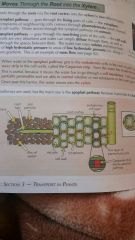![]()
![]()
![]()
Use LEFT and RIGHT arrow keys to navigate between flashcards;
Use UP and DOWN arrow keys to flip the card;
H to show hint;
A reads text to speech;
21 Cards in this Set
- Front
- Back
|
Describe the journey of water from the soil into the roots |
Root hair cells Root cortex Endodermis Xylem
|
|
|
Through which process does water enter into the roots from the soil? |
Osmosis |
|
|
Describe how the water moves into the roots in terms of water potential |
Mineral ions are actively transported into the root hair cells. This lower the wp inside the cells. Water from the cell then moves down the wp gradient into the root hair cell via osmosis |
|
|
What is the water potential of the leaves |
Low, because water constantly evaporates from them. This creates a constant water potential gradient which keeps moving the water from the roots (high) to the leaves (low) |
|
|
How does the water moves through the cortex? Name two ways |
The simplest pathway The apoplast pathway |
|
|
What happens in the symplast pathway? What process does this happen through? |
Water goes through the cytoplasm (living part). The cytoplasm of the neighbouring cells connects through plasmodesmata.
This all occurs through osmosis |
|
|
What happens in the apoplast pathway? |
Water goes through the cell walls (non living) . Diffuses across and passes through the spaces between them. |
|
|
What pressure is behind the movement of water down the apoplast pathway? |
Water travels from a region of High hydrostatic pressure to low hydrostatic pressure, along the pressure gradient.
This is an eg. of mass flow |
|
|
What does the water in the apoplast pathway encounter? How does it overcome it? |
It gets to the endodermis cells in the roots and the waxy strip called the Casparian strip blocks it's path. The water then takes the symplast path. |
|
|
Why is water passing through the symplast pathway more useful for the plant? |
Because the water has to pass through a cell membrane; since they are semi permeable, the plant is able to control what substances enter it. |
|
|
Which pathway is more used by the plant and why? |
The apoplast pathway is used more because it offers less resistance |
|

Which colour represents which pathway? |
Blue: apoplast pathway Red: symplast pathway |
|
|
What happens next in water transportation once the water has reached the xylem? |
Water moves up the xylem and out of the leaves |
|
|
Describe what happens once the water gets to the xylem: |
*Xylem vessels transport water all around the plant *at the leaves, water leaves the xylem into the cells via apoplast path *water evaporates from the cell walls into the spaces between cells in leaf *Water vapour then diffuses about of the stomata down a water potential gradient into the air |
|
|
Why does water moves up a plant? |
Becaue of: Cohesion Tension Adhesion |
|
|
Tension |
When water evaporates from the leaves (transpiration), tension (suction) is created in the xylem. This pulls more water into and up the leaf. |
|
|
Cohesion |
Water molcules are attracted to each other due to their polarity and form hydrogen bonds. They form a column/ chain of water |
|
|
Against what force does cohesion and tension help water move against? |
Gravity |
|
|
Adhesion |
Water molecules are attracted to each other and the xylem walls. This helps the water rise up through the xylem. |
|
|
What causes water to move into the Xylem? |
The wp gradient |
|
|
What do the phloemn and xylem form together in a plant? Describe its structure |

A vascular bundle; Xylem towards the middle Then vascular cambium Then phloemn |

